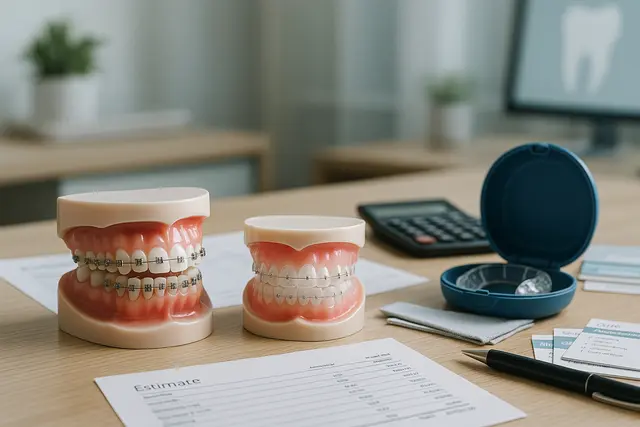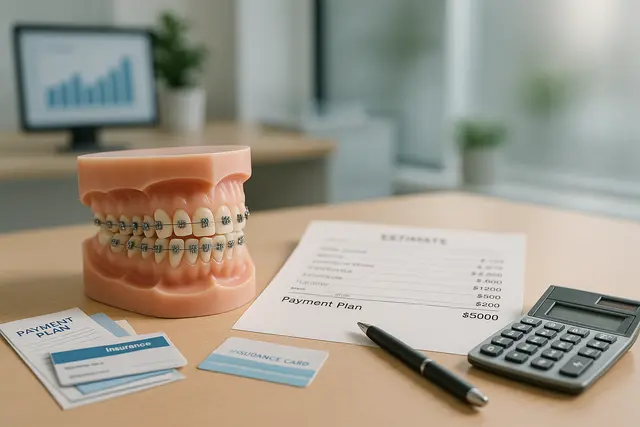Orthodontics
6 min read
Apr 03, 2025
Managing Pain and Discomfort with Braces: Tips and Remedies
Braces are an effective way to straighten teeth, but they can cause soreness and discomfort, especially after adjustments or when first applied. It's common to feel pressure around the teeth, irritation in the cheeks, or tenderness in the jaw.

Common Causes of Pain with Braces
Pain from braces is mechanical in nature. Brackets, wires, and bands work by applying pressure to your teeth, causing them to shift slowly into alignment. That process, though effective, can generate soreness in several ways.
Tightening or adjustments: Each adjustment increases controlled force on the teeth. This often leads to aching or pressure for the next 24 to 72 hours, especially when biting down.
Irritation from brackets or wires: The inside of your mouth isn’t used to the presence of sharp edges. Brackets and wires can scrape against the cheeks, lips, or tongue, producing raw spots or even small ulcers early in treatment or after a change in hardware.
Tooth movement: Pain can result from the biological response to pressure. Ligaments surrounding each tooth compress and stretch, triggering a mild inflammatory response. This is a normal part of orthodontic treatment but can cause localized discomfort.
Jaw and muscle strain: As your bite begins to shift, your jaw muscles have to adapt. This may lead to soreness in the jaw, especially if you're grinding your teeth at night or clenching in response to the stress of braces.
Each type of discomfort stems from a different part of the system, bone, gum, soft tissue, or muscle. Recognizing the source helps you manage it more effectively.
Simple Remedies That Work
Managing braces pain doesn’t require complex solutions. In most cases, simple, consistent steps can significantly reduce discomfort.
Use Orthodontic Wax
Friction between your braces and the soft tissue inside your mouth can lead to soreness. Orthodontic wax provides a buffer. Tear off a small amount, roll it into a ball, and press it over any bracket or wire causing irritation. Reapply as needed, especially before talking or eating.
Rinse with Warm Salt Water
A basic saltwater rinse can help reduce inflammation and promote healing. Dissolve a teaspoon of salt in a glass of warm water, swish gently for about 30 seconds, and spit. Use this two to three times a day, especially after meals, to clean and soothe your mouth.
Take Over-the-Counter Pain Relief
Non-prescription pain relievers like ibuprofen or acetaminophen help manage soreness following an adjustment. Use only as directed on the label and avoid prolonged use without medical input. These medications work best when taken before the pain peaks, often a few hours after an orthodontic visit.
Eat Soft Foods
Pressure on the teeth makes them more sensitive to dense or chewy textures. Choose soft, easy-to-chew foods during painful periods. Oatmeal, yogurt, steamed vegetables, soft rice, and smoothies are good options. Avoid anything sticky or hard until sensitivity goes down.
Apply a Cold Compress
Swelling and inflammation often accompany braces discomfort, particularly after tightening. A cold compress, wrapped in a towel and applied to the outside of the cheek, can numb the pain and reduce swelling. Limit use to 10-15 minutes at a time.
Stay on Schedule with Oral Hygiene
Brushing and flossing might feel uncomfortable, but skipping them can make things worse. Plaque buildup increases risk of gum inflammation and infection, both of which intensify pain. Use a soft-bristled toothbrush and fluoride toothpaste. Work gently around brackets and wires. A water flosser can help clean between teeth without undue pressure.
Ongoing Care for Mild, Persistent Pain
Discomfort that lingers between adjustments isn’t unusual. It may not be sharp or severe, but it can wear on your patience over time. Managing this low-grade pain doesn’t always require medication, daily habits and small adjustments can make a measurable difference.
Start by drinking cool water throughout the day. It can help reduce inflammation in sore areas and offers temporary numbing relief. Avoid very cold or icy drinks if your teeth are sensitive to temperature, but moderate coolness can ease general soreness.
For isolated pain spots, like a cheek sore or a tender gum, consider using an over-the-counter oral gel with benzocaine. Follow the package instructions carefully. These gels numb the surface tissues, relieving irritation and making eating or speaking more comfortable.
Dry lips are an often overlooked contributor to braces discomfort. Cracking or stretching at the corners of your mouth can amplify pain. Keep a plain, unscented lip balm on hand and apply it regularly, especially in dry weather or after prolonged talking.
If a wire continues to rub or poke, don’t ignore it. Sometimes, a quick in-office adjustment is all that's needed. Call your orthodontist and ask if they can trim or reposition a wire causing repeated irritation. It’s a minor fix that can prevent days of discomfort.
Ultimately, consistent care, paired with self-awareness, keeps persistent pain manageable. Early response helps prevent small issues from becoming bigger problems.
When to Contact Your Orthodontist
Some discomfort is expected with braces, but not all pain should be managed at home. There are situations where reaching out to your orthodontist is the right move.
A wire or bracket is loose or broken: If a component of your braces comes undone, don’t wait. Loose parts can damage your mouth and delay progress.
A wire pokes your cheek and creates a sore: Wax may help in the short term, but persistent poking requires professional adjustment to avoid infection and ongoing irritation.
Pain lasts more than a week with no sign of improvement: General soreness should ease within a few days. Pain that lingers may signal an issue with the appliance or tooth movement.
You have signs of infection like swelling, pus, or fever: These symptoms can indicate a serious problem such as an abscess. Don’t try to manage this yourself, contact your provider immediately.
When in doubt, call. It’s better to ask and be told a symptom is normal than to overlook a problem that needs clinical attention. Your orthodontist is there to support your treatment and safety.
FAQs: Pain and Braces
Why do braces hurt when they get tightened?
Tightening applies new force to your teeth, increasing the pressure needed for movement. This causes soreness as your ligaments stretch and adjust. The pain is temporary and usually eases within a few days.
How long does pain from new braces last?
Initial discomfort often lasts 3 to 5 days. It's most noticeable during the first few hours after placement and gradually improves as your mouth adjusts to the pressure and hardware.
What are the best foods to eat when my braces hurt?
When soreness sets in, stick to soft foods that require little chewing. Examples include mashed potatoes, yogurt, smoothies, soup, applesauce, and soft-boiled eggs. These ease strain on your teeth while keeping you nourished.
Can I use numbing gel for braces pain?
Yes. Gels containing benzocaine can be applied directly to sore spots inside the mouth. Use as directed, usually with a cotton swab or clean fingertip, to manage localized discomfort.
Is it normal for only one tooth to hurt with braces?
It is. Teeth move at different rates based on the treatment plan and individual response. Soreness in one or two teeth isn't unusual, especially if those are being moved more aggressively.
Does jaw pain mean something is wrong with my braces?
Not necessarily. Jaw discomfort can result from bite alignment changes or muscle fatigue. If pain worsens or doesn't improve, your orthodontist can check for uneven pressure or wire tension contributing to the issue.
Can braces cause headaches?
They can. The pressure applied to teeth and changes in bite alignment can lead to tension-type headaches in some patients. These typically resolve within a few days post-adjustment.
What can I do at night to reduce braces pain?
Before bed, use orthodontic wax to protect against irritation from brackets or wires. Take over-the-counter pain relief if needed, and elevate your head slightly with an extra pillow to help reduce nighttime swelling and pain.
Why Do Braces Cause Pain After Adjustments?
Braces apply pressure to teeth to move them gradually, and each adjustment increases that pressure. This triggers soreness in the ligaments and surrounding tissues, usually peaking 24–72 hours after the visit. It’s normal and typically fades within a few days.
How Can I Relieve Braces Pain at Home?
You can manage braces discomfort with orthodontic wax, saltwater rinses, cold compresses, and over-the-counter pain relievers like ibuprofen. Eating soft foods and staying on top of oral hygiene also reduce irritation and speed up healing between visits.
When Should I Call My Orthodontist About Braces Pain?
Contact your orthodontist if pain lasts more than a week, a wire or bracket breaks, or a wire is poking and causing a sore. You should also call if you notice swelling, pus, or fever, as these could signal an infection.
What Foods Should I Eat When My Braces Are Sore?
Stick to soft, easy-to-chew foods like mashed potatoes, yogurt, scrambled eggs, smoothies, and soup. Avoid crunchy or sticky foods until the pain eases to prevent further irritation or damage to your brackets.
Read Next
Related Posts

Orthodontics
Retainer That Looks like Braces: Benefits for Long-Term Alignment
A retainer might not get as much attention as braces, but it plays a crucial role in maintaining your smile after orthodontic treatment. Whether you're new to retainers or curious about the type that looks like braces, understanding their purpose and benefits is key to keeping your teeth aligned for the long haul.
6 min read
Sep 15, 2025

Orthodontics
How Much Are Metal Braces? Cost Comparison With Other Options
Thinking about getting braces but overwhelmed by the cost? You’re not alone. Orthodontic treatment can be a major investment, and understanding the different price points, from metal braces to clear aligners, can help you make a smart, confident decision.
5 min read
Sep 15, 2025

Orthodontics
Orthodontics & Braces Statistics (Adults + Kids)
Orthodontics has transformed from a niche medical service for teenagers into a booming sector that spans all ages. Today, both adults and children seek orthodontic treatment to improve their smiles, fix bite issues, and boost self-confidence.
4 min read
Aug 21, 2025
Don’t have time to research every dentist around you?
See why 30k+ patients trusted us